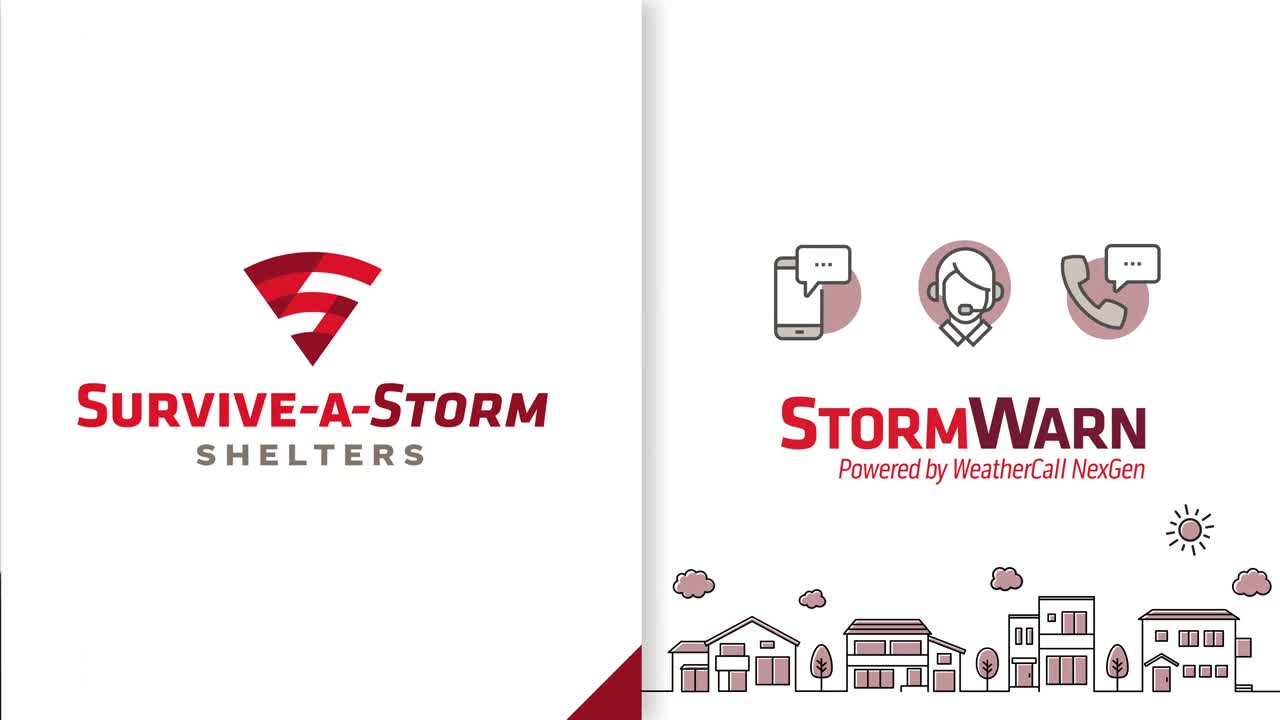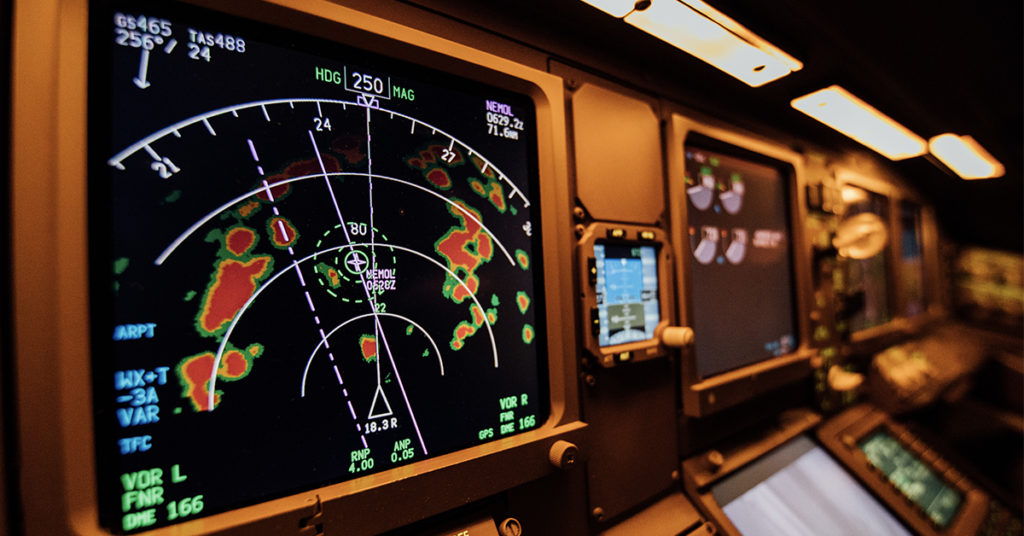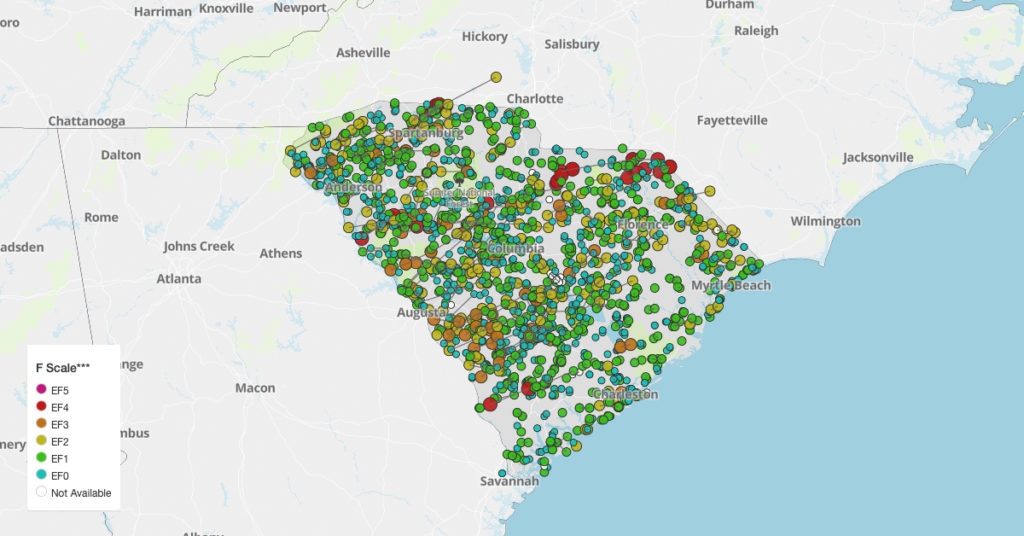Every year, South Carolina experiences tornadoes that can cause significant damage and loss of life. These storms can occur at any time of the year, but the peak season typically runs from March to May. Here is a list of facts about tornadoes in South Carolina:
- South Carolina has an average of 15-20 tornadoes per year, according to the National Weather Service.
- The deadliest tornado in South Carolina history occurred on April 30, 1924, when a tornado killed 77 people and injured more than 800 in the town of Anderson.
- South Carolina's largest outbreak of tornadoes occurred on March 28, 1984, when 22 tornadoes touched down across the state, killing 5 people and causing extensive damage.
- In recent years, the most significant tornado outbreak in South Carolina occurred on February 6, 2008, when 13 tornadoes touched down across the state, causing widespread damage and killing 9 people.
- The most common time of year for tornadoes in South Carolina is from March to May, although tornadoes can occur at any time of year.
- Some of the most tornado-prone areas in South Carolina include the Upstate region, the Midlands, and the Lowcountry.
- The strength of tornadoes in South Carolina (and all over the world!) is typically rated on the Enhanced Fujita Scale, which ranges from EF0 (weak) to EF5 (violent).
- The tornado with the highest rating ever recorded in South Carolina was an EF4 tornado that struck the town of Holly Hill on April 13, 1970, causing significant damage and killing 7 people.
- South Carolina's tornadoes are often associated with severe thunderstorms, which can produce large hail, damaging winds, and flash flooding.
- Despite the risks associated with tornadoes in South Carolina, the state has a well-established system of tornado warning and response, including the use of sirens, weather radios, and emergency alerts.
Documented South Carolina tornadoes since 1950

Know when severe weather is about to strike and when it's time for you to take shelter with our StormWarn texting program.

Preparing for Tornadoes in South Carolina
Because tornadoes can strike with little warning and cause significant damage and loss of life, if you live in an affected area, you should take steps to prepare for these dangerous weather events. In South Carolina, the risk of tornadoes is particularly high during the spring months.
Preparation is critical since tornadoes can damage homes, businesses, and infrastructure. Strong winds, flying debris, and flooding can create hazardous conditions that can put people's lives at risk. The most effective way to protect yourself, and your family from tornadoes is to have a designated tornado shelter (in your home and at work), and also to have a plan in place before a tornado strikes.
One important aspect of tornado preparation is knowing the risks associated with tornadoes and understanding the warning signs. South Carolina has a robust system of tornado warning and response, including the use of sirens, weather radios, and emergency alerts. By staying informed and taking action when a warning is issued, residents can help minimize the damage caused by tornadoes.
Another critical component of tornado preparation is having an emergency kit on hand. This kit should include essential items such as water, non-perishable food, first-aid supplies, and a battery-powered radio. As mentioned earlier, a place to take shelter is crucial to your tornado action plan. If you don’t have a designated tornado shelter in your home or business, it’s important to know what the next best place to be is, whether that is in a community storm shelter or an interior room on the lowest level of your home.
By taking the time to understand the risks, develop a plan, and gather necessary supplies, residents can protect themselves and their property from the potentially devastating impacts of tornadoes.

Tornado Shelters Near Me in South Carolina
In South Carolina, public tornado shelters are typically operated by local governments, emergency management agencies, or non-profit organizations. Here are some resources that can help you find public tornado shelters in South Carolina:
- The South Carolina Emergency Management Division (SCEMD) maintains a list of public shelters throughout the state, including tornado shelters. You can find this list on their website, or by calling their toll-free information line at 1-866-246-0133.
- Through the SCEMD, each county in South Carolina has its own emergency management agency, which may operate public tornado shelters. You can find contact information for your local shelters at https://www.scemd.org/stay-informed/emergency-shelters/
- The American Red Cross has chapters in South Carolina and often operates public shelters during disasters, including tornadoes. You can search for Red Cross shelters in South Carolina using the "Find Open Shelters" tool on their website.
- During severe weather events, local media outlets often provide information about public tornado shelters. You can check the websites or social media pages of local TV and radio stations, or check their broadcasts for updates.
- South Carolina is located in Region 4 of the Federal Emergency Management Agency (FEMA). FEMA provides funding for the construction and operation of tornado shelters in some communities. If you live in an area that has received FEMA funding for tornado shelters, you can contact your local emergency management agency to find out where the shelters are located.
Public tornado shelters may not be suitable for everyone, so it's essential to have a plan for sheltering in place in case you cannot make it to a public shelter during a tornado warning. This may include buying a designated tornado shelter from a member of the NSSA.
Be sure to stay informed about tornado risks in your area and take steps to protect yourself and your family.
Tornado Safety Tips
Here are some tornado safety tips that can help you stay safe in South Carolina:
- Monitor weather forecasts and be aware of the risk of tornadoes in your area. Sign up for local weather alerts and have a battery-powered radio or weather radio on hand to receive updates if power goes out. There are also location-based tornado alerts that tell you exactly when to take shelter.
- Develop an emergency plan for your family and make sure everyone knows what to do if a tornado warning is issued. Designate a safe place where you can take shelter during a tornado, such as a storm shelter or a small interior room on the lowest level of your home.
- Assemble an emergency kit with essential supplies, including water, non-perishable food, first-aid supplies, and a flashlight with extra batteries.
- Make sure outdoor furniture, decorations, and equipment are secured or brought inside before a tornado warning. Close and secure windows and doors, and check the condition of your roof when high winds are anticipated.
- If a tornado warning is issued, stay inside and take shelter immediately. If you’re in an area with no storm shelter, avoid windows, exterior walls, and doors, and protect your head with a helmet or a cushion. Go to the lowest level of the building.
- If you're in a vehicle, pull over to a safe location, get out, and lie down in a ditch or other low-lying area.
- Stay put: Wait until the tornado has passed and listen for emergency alerts before leaving your shelter. Avoid downed power lines and other hazards, and be cautious of debris and flooding.
By following these tornado safety tips, you can help protect yourself, your family, and your property from the potential dangers of tornadoes in South Carolina.

South Carolina Tornado Shelter FAQs
Q: What causes tornadoes in South Carolina?
A: Tornadoes in South Carolina are typically caused by severe thunderstorms, which are produced when warm, moist air collides with cooler, drier air. As the two air masses collide, they create instability in the atmosphere, which can lead to the formation of tornadoes. South Carolina is part of "Dixie Alley."
Q: When is tornado season in South Carolina?
A: The peak tornado season in South Carolina runs from March to May, although tornadoes can occur at any time of the year. During these months, the combination of warm, moist air from the Gulf of Mexico and cooler, drier air from the north can create the conditions necessary for tornadoes to form.
Q: What should I do if a tornado warning is issued?
A: If a tornado warning is issued, it's important to be prepared to take immediate action to protect yourself and your family. When your location is in the “polygon area” or when meteorologists have advised, it is time to seek shelter. If you're caught outside, seek shelter in a low-lying area, such as a ditch or culvert, and cover your head with your hands.
Q: What's the difference between a tornado watch and a tornado warning?
A: A tornado watch means that conditions are favorable for tornadoes to form in the area, while a tornado warning means that a tornado has been sighted or detected on radar and is imminent. If a tornado warning is issued, be prepared to take immediate action to protect yourself and your family. It's also a good idea to understand what the "polygon area" is for each storm.
Q: Can tornadoes occur at night?
A: Yes, tornadoes can occur at any time of the day or night, although they are more difficult to see and detect at night. It's important to have a way to receive weather alerts even while you're sleeping, such as a weather radio or smartphone app.
Q: What should I include in a tornado emergency kit?
A: A tornado emergency kit should be part of your family's tornado plan and should include essential items such as water, non-perishable food, a first aid kit, a flashlight, extra batteries, a weather radio, and any necessary medications. It's also a good idea to have chargers for your phones.
Q: How do I prepare my home for a tornado?
A: To prepare your home for a tornado, make sure to secure loose objects such as lawn furniture and debris. Trim trees and branches near your home, and check the condition of your roof. It's also a good idea to designate a safe room or shelter area in your home, such as a basement or interior room on the lowest level. Ideally, it's also possible to install a residential tornado shelter approved by the NSSA and Texas Tech Wind Institute.
Q: What's the difference between a tornado and a hurricane?
A: A tornado is a small, rapidly rotating column of air that touches the ground, while a hurricane is a large, rotating storm system that forms over the ocean and can cause widespread damage and flooding. While both can be deadly, tornadoes are typically smaller in scale and occur more frequently than hurricanes. It is also possible for hurricanes to spawn tornadoes.
Q: How common are tornadoes in South Carolina?
A: South Carolina averages around 15-20 tornadoes per year, although the number can vary from year to year. Tornadoes can occur in any part of the state, but are most common in the northern and central regions.
Q: What should I do after a tornado has passed?
A: After a tornado has passed, it's important to stay inside and avoid hazards such as downed power lines and debris. If you're trapped, try to signal for help with a whistle or other loud noise. Check on your family and neighbors, and listen to local authorities for information on recovery efforts. Some tornado alert systems, like StormWarn, are also designed to deliver an "all clear" once the danger is over.



